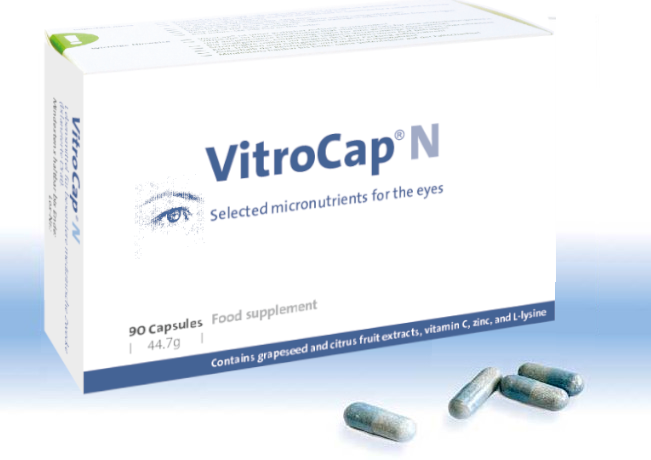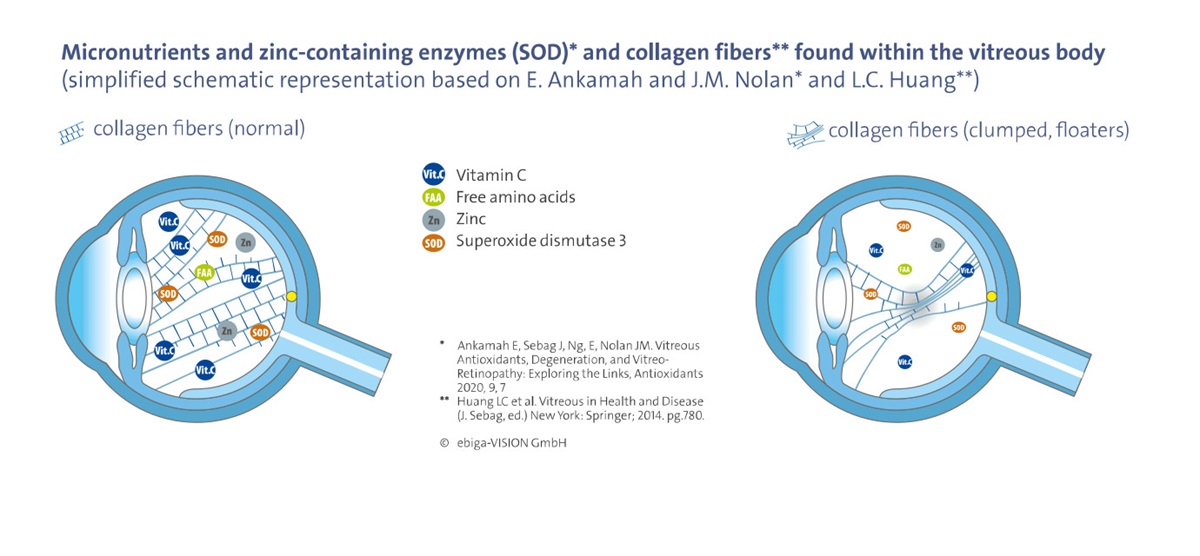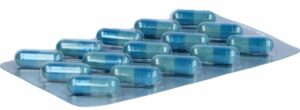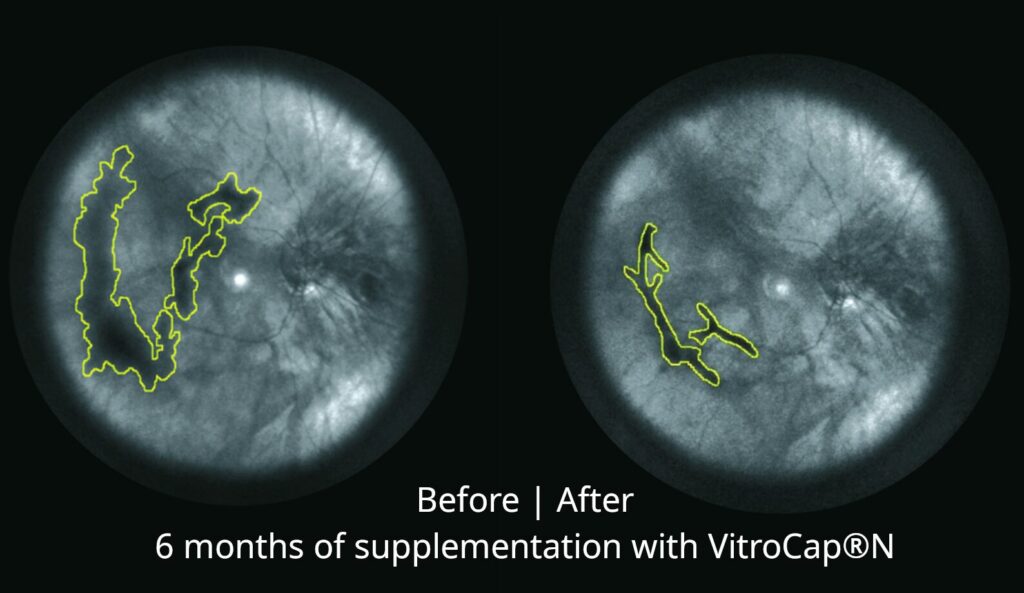
Since 2013, substantial scientific research has evaluated the effectiveness of micronutrient supplementation in managing eye floaters.
The most recent Floater Intervention Study (FLIES) stands out as particularly significant. Not only did it show improvements in subjective visual disturbance scores and improved visual function, but researchers also utilized the ultra-widefield imaging module of the SPECTRALIS HRA + OCT from Heidelberg Engineering GmbH to capture a 30-second, 102° field, cross-polarized infrared reflectance video of the vitreous. From this video, five still images of eye floaters were extracted, making the areas of vitreous opacities visible. After 6 months, objective improvement of eye floaters was proven in 77% of patients.
Explore this page to discover everything about the tested micronutrient VitroCap®N—its mechanism of action, clinical feedback, and instructions for ordering samples or stocking it in practice shops, and more.
Research Team | Year | Duration | Design | Success Rate |
|---|---|---|---|---|
Ankahmah et al | 2021 | 6 months | RCT (double-blind) | 66.7% |
Varganova et al. | 2019 | 3 months | Case-control study | 76% |
Sobol et al. | 2018 | 3 months | Observational study | 64.7% |
Marchencko et al. | 2015 | 3 months | Case-control study | 65.5% |
Kaercher et al. | 2013 | 3 months | Observational study | 87.5% |
After 6 months, objective improvement of eye floaters was proven in 77% of patients. Fill out the form to receive the complete study data via email.

The vitreous body has a unique protective mechanism against oxidative stress and collagen glycation. However, this mechanism loses efficacy during degeneration. Providing the eye with naturally occurring micronutrients can help reactivate this mechanism, minimising or even preventing collagen fibres from clumping. The healthy vitreous exhibits notably high concentrations of micronutrients, including:

Other micronutrients are known to effectively combat oxidative stress and protein glycation:
Incorporating these micronutrients through supplementation with VitroCap®N may potentially slow down or even reverse, the progression of floaters. The effectiveness of this approach has been demonstrated in five clinical trials.
Did you know that eye care professionals can request free samples of VitroCap®N here?
Nutritional information | Per capsule = Recommended daily intake | Percentage of reference intake per capsule* |
|---|---|---|
Zinc
| 5 mg
| 50% |
Vitamin C
| 40 mg
| 50%
|
Grape seed extract | 26,3 mg
| ** |
– of which proanthocyanidins
| 25 mg
| ** |
Citrus fruit extract | 100 mg
| ** |
– of which citrus flavonoids (hesperidin)
| 60 mg
| ** |
L-Lysine
| 125 mg
| ** |
* Percentage of the reference intake per EU Regulation 1169/2011
** no nutrient reference values available / no recommendation available in the EU
Gluten-free, lactose-free, made in Europe

In the Floater Intervention Study (FLIES), researchers used the ultra-widefield imaging module of the SPECTRALIS HRA + OCT from Heidelberg Engineering GmbH to capture a 30-second, 102° field, cross-polarised infrared reflectance video of the vitreous. Patients were asked to move their gaze in various directions, returning to a central fixation point after each movement. From the video, five still images of eye floaters were extracted, each from a different angle.
The vitreous opacity outlines were manually delineated using a ‘freehand selection‘ tool, and the areas of opacity were calculated for each image. These individual areas were then combined to provide a total measurement, reported in square centimetres.

Did you know?
The FLIES study is the first randomised, double-blind, placebo-controlled clinical trial to assess the impact of targeted nutritional supplementation on vitreous floaters. The trial included 61 patients aged 18-79 years. After 6 months of supplementation with VitroCap®N, 77% of patients experienced a reduction in vitreous opacity areas.
VitroCap®N has been on the market for over 10 years, with eye care professionals across Europe gathering valuable clinical experience. These experts have shared their insights, contributing to a broader understanding of the supplement’s impact. In discussions and contributions from both internationally and nationally renowned physicians and researchers, the latest findings on vitreous degeneration were explored, including its effects on visual function and quality of life.
See the full discussion on YouTube.
The videos from the symposium can be found here.
Research Team | Year | Duration | Design | Success Rate | Link |
|---|---|---|---|---|---|
Ankahmah et al | 2021 | 6 months | RCT (double-blind) | 66.7% | https://www.ncbi.nlm.nih.gov/pmc/articles/PMC8525826/ |
Varganova et al. | 2019 | 3 months | Case-control study | 76% | https://journals.eco-vector.com/ov/article/view/11875 |
Sobol et al. | 2018 | 3 months | Observational study | 64.7% | https://www.researchgate.net/publication/326345092 |
Marchencko et al. | 2015 | 3 months | Case-control study | 65.5% | https://ebiga-vision.com/marchencko-et-al.pdf |
Kaercher et al. | 2013 | 3 months | Observational study | 87.5% | https://ebiga-vision.com/ZPA_9-2023-eye-floater-symposium |
ebiga-VISION aims to give you the opportunity to assess the product yourself, provide your patients with comprehensive and straightforward advice, and offer them an evidence-based option for the management of floaters.
Please contact us using our contact form. We would be happy to send you a PDF with our current prices and discount levels for practice shop owners. You can also easily reach us by phone to place an order.

In most countries, patients can conveniently order VitroCap®N from selected pharmacies or trusted online retailers. It is also available through the official distributor, ebiga-VISION, and their authorized partner shops. Simply click on your country flag to be redirected to the relevant shop page.
Leave a brief message and a member of ebiga-VISION will contact you as soon as possible